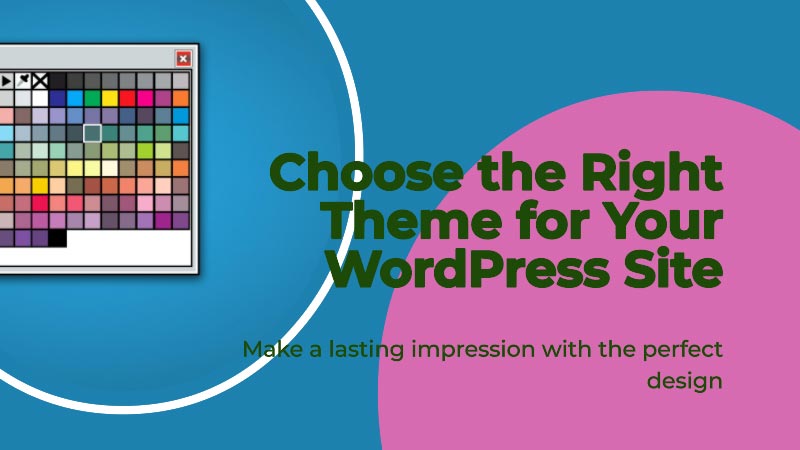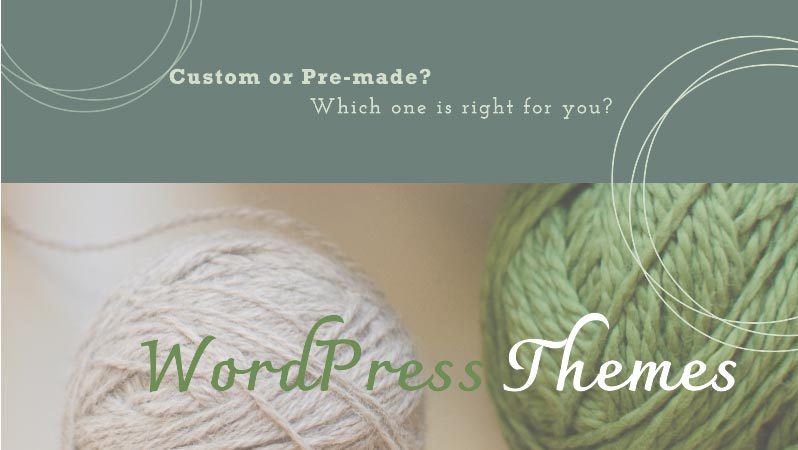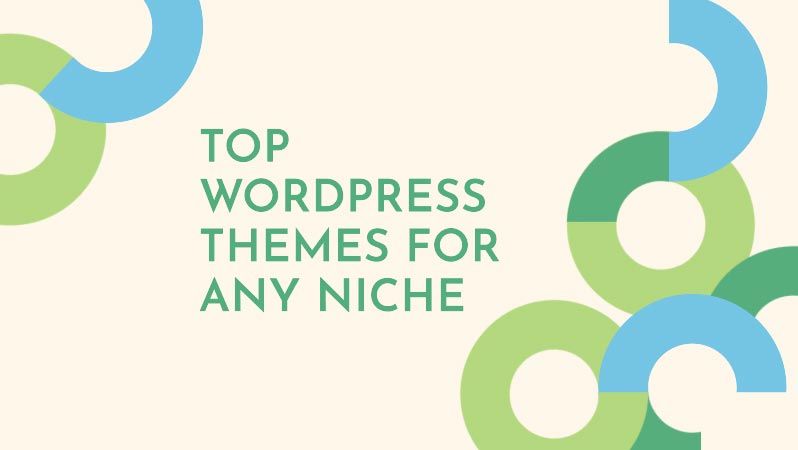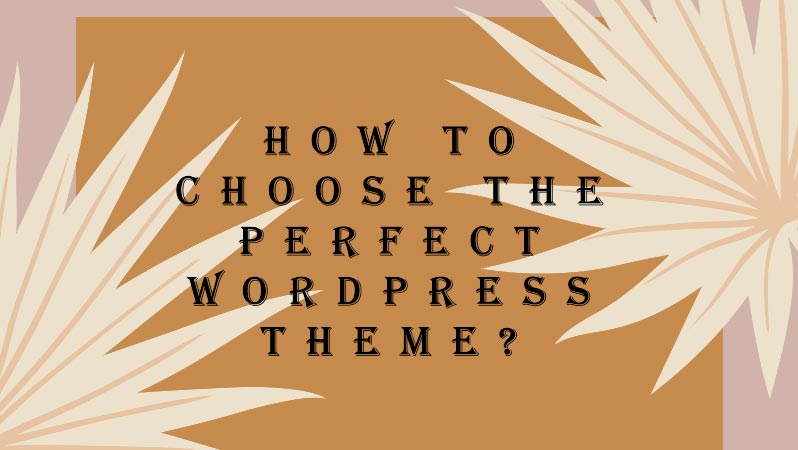Confused as to how to choose a perfect WordPress theme for your WordPress site – Then this post is for you.
Choosing the perfect WordPress theme is a critical step in building a successful website. With thousands of options available, it can be overwhelming to select the one that suits your needs. In this comprehensive guide, we will explore the essential factors to consider when choosing a WordPress theme, ensuring that your website not only looks great but also functions effectively.
Why is it Important to choose the perfect WordPress theme?

Choosing the right WordPress theme is crucial for several reasons, especially if you’re running a website for personal blogging, business, or any other purpose.
Here are some key reasons why selecting the appropriate WordPress theme is important:
- First Impressions Matter: Your website’s design is the first thing visitors notice. A well-designed theme creates a positive first impression, making visitors more likely to stay and explore your site further.
- User Experience: A good theme ensures a positive user experience. It should be easy to navigate, mobile-friendly, and accessible. A confusing or poorly designed theme can drive visitors away.
- Customization: The right theme allows you to customize your website according to your needs. Customization options can include changing colors, layouts, fonts, and adding custom widgets.
- Speed and Performance: Some themes are optimized for speed and performance. Slow-loading websites can frustrate visitors and negatively impact search engine rankings. Choosing a lightweight and optimized theme is essential for a fast-loading site.
- SEO Friendliness: SEO is crucial for driving organic traffic to your website. A well-coded theme that follows SEO best practices can improve your site’s visibility in search engine results.
- Security: While WordPress itself is secure, poorly coded themes can create vulnerabilities. It’s important to choose themes from reputable sources like the official WordPress repository or trusted theme marketplaces to ensure security standards.
- Support and Updates: Regular updates are essential to keep your website secure and compatible with the latest WordPress version. Premium themes often come with dedicated support, ensuring you can get help if you encounter issues.
- Brand Identity: Your website’s design should reflect your brand identity. A suitable theme allows you to incorporate your logo, brand colors, and other elements that reinforce your brand message.
- Content Presentation: Different themes present content in various ways. Choosing a theme that complements your content type enhances its visual appeal and readability.
- Mobile Responsiveness: With the use of smartphones and tablets, it’s crucial to have a responsive theme. Google also considers mobile-friendliness when ranking websites in search results.
How to choose the right WordPress theme?

Understanding Your Needs and Goals
Before diving into the vast sea of WordPress themes, it’s crucial to have a clear understanding of your website’s purpose, target audience, and functionality requirements. Here are some questions to consider:
- What is the purpose of your website?
- Is it a blog, business website, portfolio, e-commerce store, or a combination of these?
- Do you need specific features like a contact form, portfolio showcase, or online store?
- Who is your target audience?
- Consider the demographics and preferences of your audience. What kind of design and layout would appeal to them?
- What is your budget?
- Determine how much you are willing to invest in a premium theme, if necessary.
- Do you need ongoing support and updates?
- Premium themes often come with dedicated support and regular updates. Evaluate whether this is essential for your website.
Choosing Between Free and Premium Themes
WordPress offers both free and premium themes. Each has its pros and cons:
- Free Themes:
- Pros:
- Cost-effective
- Wide variety available
- Cons:
- Limited support and customization options
- Less unique, as many users might be using the same theme
- Pros:
- Premium Themes:
- Pros:
- Dedicated support
- Regular updates with new features and security patches
- Unique designs and customization options
- Cons:
- Cost involved
- Pros:
Evaluating Design and Layout
- Responsiveness:
- Ensure the theme is mobile-friendly and responsive across various devices and screen sizes.
- Customization Options:
- Look for themes with an intuitive customization interface that allows you to modify colors, fonts, and layout easily.
- Typography and Readability:
- Choose a theme with readable fonts and proper line spacing to enhance the overall user experience.
- Visual Appeal:
- Opt for a design that reflects your brand identity and appeals to your target audience.
Assessing Features and Functionality
- Plugin Compatibility:
- Ensure the theme is compatible with popular WordPress plugins you plan to use, such as SEO tools, contact forms, or e-commerce solutions.
- Page Builders Integration:
- Themes compatible with popular page builders like Elementor or Beaver Builder offer enhanced customization options.
- Speed Optimization:
- Choose a theme optimized for speed to provide a fast-loading experience for your visitors.
- SEO-Friendliness:
- Look for themes that follow SEO best practices, including clean code and mobile-friendliness.
Checking Security and Code Quality
- Code Quality:
- Inspect the theme’s code to ensure it is well-written, follows WordPress coding standards, and is not bloated with unnecessary elements.
- Security:
- Opt for themes from reputable sources to minimize the risk of security vulnerabilities. Read user reviews and ratings to gauge the theme’s reliability.
Reviewing Support and Documentation
- Support Options:
- Determine the level of support provided (forum, email, live chat) and the response time. Premium themes usually offer better support.
- Documentation:
- Check if the theme has comprehensive documentation and tutorials, helping you understand its features and customization options.
User Reviews and Ratings
- User Feedback:
- Read user reviews and ratings to learn about other users’ experiences with the theme. Consider both positive and negative feedback.
- Community and Forums:
- Active community forums indicate ongoing development and support. Check if the theme’s developers actively participate in the WordPress community.
Testing the Demo
- Demo Site:
- Explore the theme’s demo site thoroughly to understand its functionality, design elements, and user experience.
- Interactivity:
- Test interactive elements such as forms, sliders, and navigation menus to ensure they work smoothly.
Considering Future Scalability
- Scalability:
- Choose a theme that allows room for growth and future modifications. Consider whether it can accommodate additional features as your website expands.
- Updates and Compatibility:
- Ensure the theme is regularly updated to remain compatible with the latest WordPress version and plugins.
Where you can find your dream WordPress theme for your website?

WordPress, the world’s most popular content management system (CMS), powers millions of websites and blogs across the internet. One of the reasons behind its widespread adoption is the flexibility it offers through themes. WordPress themes are pre-designed templates that allow users to customize the look and feel of their websites without extensive coding knowledge. Whether you’re starting a blog, a business website, an online store, or any other type of website, choosing the right WordPress theme is crucial for creating a visually appealing and functional site.
In this section, we’ll explore the various avenues where you can find WordPress themes, discuss factors to consider when choosing a theme, and provide tips for ensuring that the theme you select aligns with your website’s goals.
Official WordPress Theme Repository:
The official WordPress Theme Repository, also known as the WordPress Theme Directory, is the first place you should explore. Accessible directly from your WordPress dashboard, this repository offers a vast collection of free themes. These themes are regularly reviewed by WordPress volunteers to ensure they meet the platform’s standards regarding security and code quality.
Advantages:
- Free of Cost: Most themes in the repository are free to download and use, making it an excellent choice for budget-conscious users.
- Security: Themes in the repository undergo a review process, reducing the risk of security vulnerabilities.
- Easy Installation: Themes can be installed directly from your WordPress dashboard, eliminating the need for manual downloads and uploads.
Disadvantages:
- Limited Customization: Free themes might have limited customization options compared to premium themes.
- Common Design: Since these themes are free, they might be used by many websites, leading to a lack of uniqueness.
Premium Theme Marketplaces:
If you’re willing to invest in a high-quality, feature-rich theme, premium theme marketplaces are the way to go. Websites like ThemeForest, Elegant Themes, and StudioPress offer a wide range of professionally designed themes for various purposes.
Advantages:
- Design Quality: Premium themes often boast superior design quality and attention to detail.
- Support and Updates: Purchasing a premium theme usually grants you access to dedicated customer support and regular updates, ensuring compatibility with the latest WordPress version.
- Advanced Features: Premium themes often come bundled with advanced features, such as custom widgets, page builders, and multiple layout options.
Disadvantages:
- Cost: Premium themes come at a price, which might not be suitable for users with tight budgets.
- Learning Curve: Some premium themes, especially those with extensive customization options, might have a learning curve for beginners.
Theme Developer Websites:
Many reputable theme developers and design agencies have their own websites where they sell themes directly to users. These developers often provide detailed documentation, demos, and customer support, making it easier for users to make informed decisions.
Advantages:
- Direct Support: Purchasing from the developer’s website often means direct access to their support team, ensuring quick and efficient assistance.
- Unique Designs: Developers frequently offer unique and innovative designs that might not be available on popular marketplaces.
Disadvantages:
- Limited Reviews: Unlike themes on well-known marketplaces, themes from individual developers might have fewer user reviews and ratings.
Custom WordPress Theme Development:
For users with specific design requirements or a unique vision for their website, custom WordPress theme development is the ideal solution. Hiring a professional web developer or agency to create a custom theme tailored to your needs ensures complete control over the design and functionality of your website.
Advantages:
- Unlimited Customization: Custom themes can be tailored to match your brand identity and include specific features tailored to your audience.
- Scalability: Custom themes can be designed with future scalability in mind, accommodating your website’s growth and changing needs.
Disadvantages:
- Cost: Custom development is the most expensive option and might not be suitable for small budgets.
- Time-Consuming: Developing a custom theme takes time, involving extensive planning, design, and development phases.
Free Theme Resources:
Apart from the official WordPress repository, there are other websites where you can find free WordPress themes. Websites like WordPress.org, ThemeIsle, and Colorlib offer a selection of free themes that have been vetted for quality.
Advantages:
- Diverse Selection: These platforms often curate themes from various developers, providing a diverse selection of styles and functionalities.
- Quality Assurance: Free themes on reputable websites are generally well-coded and designed, ensuring a positive user experience.
Disadvantages:
- Limited Features: Free themes might lack some advanced features found in premium themes.
- Support Discrepancy: Free themes may not come with extensive customer support, leaving users reliant on community forums and documentation for assistance.
Choosing the Right Theme:

Regardless of where you find your WordPress theme, there are several key factors to consider during the selection process:
Purpose of Your Website: Consider the primary goal of your website. Whether you’re creating a portfolio, a blog, an online store, or a business website, choose a theme that aligns with your website’s purpose and target audience.
Design and Layout: Evaluate the theme’s design and layout options. Besides, look for a clean and responsive design that adapts well to different screen sizes and devices. Furthermore, customizability is also essential; ensure the theme allows you to modify colors, fonts, and layout elements easily.
Performance and Speed: A fast-loading website is crucial for user experience and search engine optimization. Additionally, check the theme’s performance by using tools like Google PageSpeed Insights or GTmetrix to ensure it is optimized for speed.
Compatibility: Ensure the theme is compatible with the latest version of WordPress. Moreover, check if it integrates seamlessly with popular plugins like WooCommerce, SEO plugins, and contact form plugins.
Security: Prioritize themes from reputable sources to minimize security risks. However, themes from WordPress repositories and well-known marketplaces are safe choices.
Reviews and Ratings: If you’re considering a theme from a marketplace or developer website, read user reviews and ratings. Apart from that, feedback from other users can provide valuable insights into the theme’s quality and customer support.
Support and Documentation: Consider the availability of customer support and documentation. However, premium themes and themes from reputable developers often come with dedicated support teams and detailed documentation to assist users in setting up and customizing their websites.
Customization Options: Evaluate the theme’s customization options. Therefore, look for themes that offer a balance between flexibility and ease of use. In addition, themes with integrated page builders or theme customizer tools provide users with greater control over their website’s appearance.
Custom Themes vs. Premade Themes: Decoding the Dilemma

In the vast and ever-evolving landscape of web design, one of the pivotal decisions that designers and businesses face is choosing between custom themes and premade themes. The choice between these two options is not merely a matter of aesthetics; it involves considerations of functionality, uniqueness, user experience, and budget constraints.
Each option carries its own set of advantages and drawbacks, and the decision ultimately depends on the specific needs and goals of the website in question. In this comprehensive exploration, we will delve deep into the intricacies of custom themes and premade themes, analyzing their respective merits and demerits, to aid in making an informed decision.
Understanding Custom Themes
Tailored to Perfection
Custom themes, as the name suggests, are built from scratch according to the specific requirements of a website. This level of customization allows designers to create a unique and tailor-made user experience. Every element, from layout to typography, is meticulously crafted to align with the brand identity and user expectations. This bespoke approach ensures that the website stands out from the crowd, making a strong impression on visitors.
Unparalleled Flexibility
One of the significant advantages of custom themes is the unparalleled flexibility they offer. Designers have complete control over the website’s features and functionalities. This freedom enables the implementation of innovative design elements, interactive interfaces, and seamless navigation, tailored to enhance the user experience. Custom themes can adapt and evolve with the changing needs of the website, ensuring its longevity and relevance.
Optimal Performance
Custom themes are optimized for performance. Since every line of code is written with the specific website in mind, there is minimal bloat and unnecessary elements. This streamlined approach results in faster loading times, smoother animations, and overall improved performance. Optimized websites not only provide a superior user experience but also rank higher in search engine results, contributing to increased visibility and traffic.
Scalability and Growth
Custom themes are inherently scalable, allowing websites to grow and expand seamlessly. Whether it’s integrating new features, accommodating a growing user base, or adapting to technological advancements, custom themes can be easily modified and scaled without compromising the website’s integrity. This scalability ensures that the website remains agile and responsive to changing market demands and user preferences.
Exploring Premade Themes
Ready-Made Convenience
Premade themes offer unmatched convenience. They come prepackaged with a variety of designs, layouts, and functionalities, eliminating the need for extensive development time. For businesses or individuals with limited resources and tight deadlines, premade themes provide an excellent starting point. With just a few clicks, a website can be up and running, saving valuable time and effort.
Cost-Effectiveness
From a budgetary perspective, premade themes are significantly more cost-effective than custom themes. They are often priced lower and do not entail the expenses associated with hiring a professional web designer or developer. For small businesses and startups operating on a tight budget, premade themes offer an affordable solution to establish an online presence without breaking the bank.
Support and Updates
Premade themes usually come with dedicated support and regular updates from the theme developers. This ongoing support ensures that the website remains secure, bug-free, and compatible with the latest web technologies. For individuals or businesses lacking technical expertise, this support system is invaluable, providing peace of mind and allowing them to focus on their core activities while relying on experts to handle the technical aspects.
Limited Customization
While premade themes offer convenience and affordability, they come with a limitation: limited customization. While some degree of customization is possible, there are constraints regarding altering the fundamental structure and features of the theme. This limitation can be a drawback for businesses with unique branding requirements or specific functionalities that are not readily available in premade themes.
The Decision-Making Dilemma
Factors Influencing the Choice
Several factors influence the decision between custom themes and premade themes. The nature of the website, the target audience, budget constraints, and the desired level of uniqueness all play a crucial role. For businesses aiming for a distinctive online identity that aligns perfectly with their brand values, a custom theme is often the preferred choice. Conversely, individuals or small businesses with limited resources and a need for quick deployment might find premade themes more suitable.
Striking a Balance: Hybrid Approaches
In some cases, a hybrid approach can be adopted to strike a balance between customization and convenience. Designers can start with a premade theme as a foundation and then customize specific elements to align with the brand identity. This approach allows for a quicker setup while ensuring a degree of uniqueness and tailored design. However, it requires careful planning to avoid over-customization, which can lead to performance issues and complexity in the long run.
Conclusion: Making the Right Choice
In the eternal custom vs. premade theme debate, there is no one-size-fits-all answer. The choice ultimately depends on the specific requirements, goals, and constraints of the website in question. Custom themes offer unparalleled flexibility, optimal performance, and scalability, making them ideal for businesses with unique branding needs and a long-term vision. Premade themes, on the other hand, provide convenience, cost-effectiveness, and ongoing support, making them a practical choice for individuals and small businesses with limited resources and time constraints.
In essence, the key is to strike a balance between customization and convenience. Businesses and individuals must carefully assess their needs and resources, exploring the possibilities offered by both custom and premade themes. By making an informed decision based on a thorough understanding of the advantages and limitations of each option, they can create a compelling online presence that resonates with their audience and achieves their objectives.
In the ever-evolving digital landscape, the choice between custom themes and premade themes will continue to be a crucial consideration for web designers and businesses alike. By embracing the strengths of each approach and adapting them to specific contexts, the dilemma can be decoded, leading to the creation of visually stunning, user-friendly, and successful websites that leave a lasting impression on visitors.
List of the Best WordPress themes for any niche

There are thousands of WordPress themes available, each catering to different types of websites and design preferences. While the “best” WordPress theme can vary depending on your specific needs, here are some highly regarded themes that have consistently received positive feedback from users and developers. Please note that the popularity and quality of themes can change over time, so it’s always a good idea to check the latest reviews and updates before making a decision.
Best WordPress Themes for any website:
- Divi: Divi is a powerful and versatile theme, featuring a drag-and-drop builder and a wide range of templates. It is customizable and suitable for various types of websites.
- Astra: Astra is a lightweight and customizable theme that works well with popular page builders like Elementor and Beaver Builder. Furthermore, it offers starter templates for various niches and is known for its speed and performance.
- OceanWP: OceanWP is an extendable theme with a focus on performance. In addition, it offers a variety of demo sites and integrates with popular page builders. It’s known for its flexibility and compatibility with e-commerce plugins.
- Hestia: Hestia is a modern one-page theme suitable for startups, businesses, and creative agencies. Additionally, it offers a clean design, and easy customization options, and works well with page builders.
- Enfold: Enfold is a theme with a drag-and-drop builder and a wealth of customization options. It’s multipurpose and can be used for various types of websites.
- Avada: Avada is one of the best-selling themes on ThemeForest. Besides, it comes with a powerful fusion builder. Also, it offers an array of design options and is suitable for creating complex websites without any coding knowledge.
- The7: The7 is a feature-rich and customizable theme that offers a variety of design styles. It includes a visual composer and Ultimate Addons for Visual Composer, allowing for easy customization.
- Neve: Neve is a lightweight and fast-loading theme that integrates with popular page builders. Moreover, it offers various starter sites and is suitable for blogs, portfolios, and small business websites.
- GeneratePress: GeneratePress is a lightweight and responsive theme known for its speed and performance. It’s compatible with popular page builders and offers a range of customization options through its premium version.
- X Theme: X Theme is a versatile and powerful theme that includes many unique designs within one package. Apart from that, it comes with a page builder called Cornerstone, offering endless possibilities for customization.
Conclusion
In summary, the right WordPress theme can significantly impact your website’s success. Moreover, it affects how visitors perceive your site, how easily they can use it, and how well it performs in terms of speed, SEO, and security. Therefore, it’s important to invest time in selecting a theme that aligns with your goals and provides a positive user experience.
Remember, the best theme for your WordPress site depends on your specific requirements, such as design preferences, features, and functionality. Always check the latest reviews, support options, and compatibility with plugins before making a decision.
Above all, finding the perfect WordPress theme involves a combination of research, analysis, and consideration of your website’s specific needs. Whether you opt for a free theme from the WordPress repository, invest in a premium theme from a marketplace, explore individual developer websites, or pursue custom development, the key is to choose a theme that enhances your website’s functionality and visual appeal.
Now over to you,
Have you found your favorite choice of WordPress theme?
How did you choose the perfect right WordPress theme?
Please let us know your thoughts and follow us on Facebook and Twitter.
